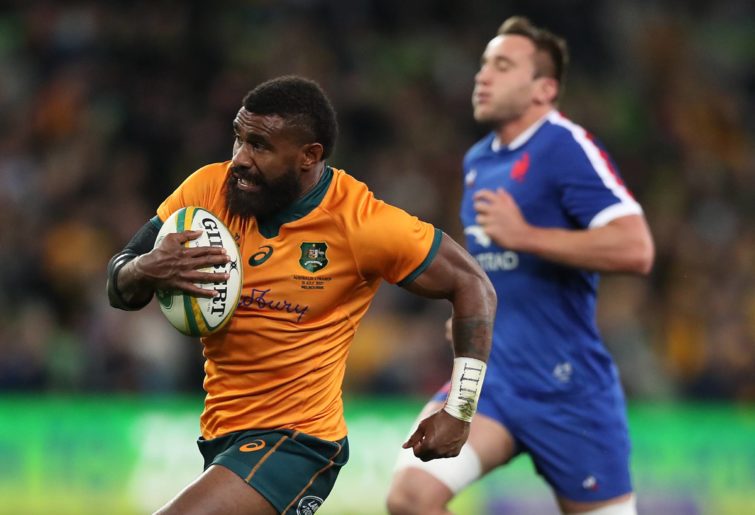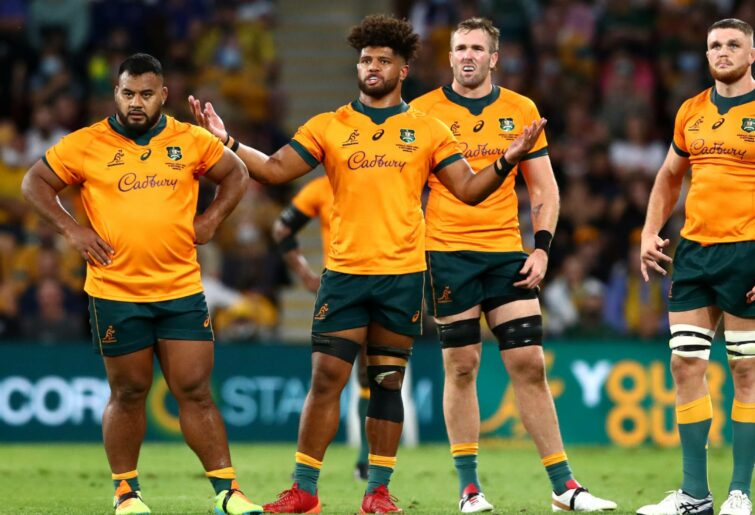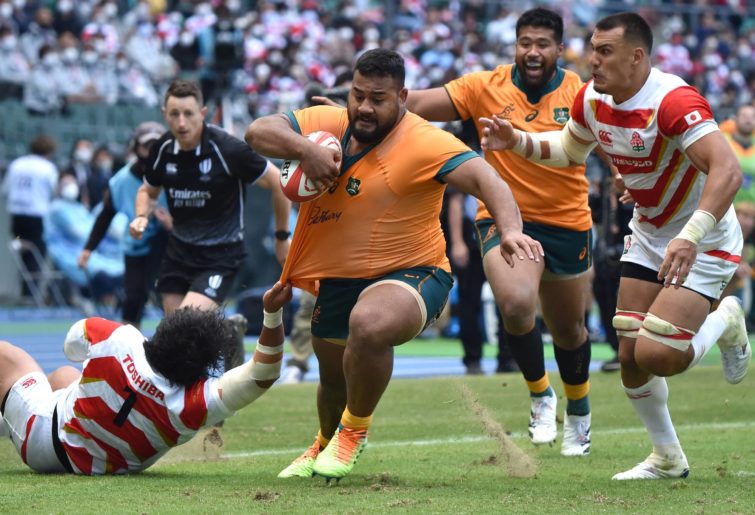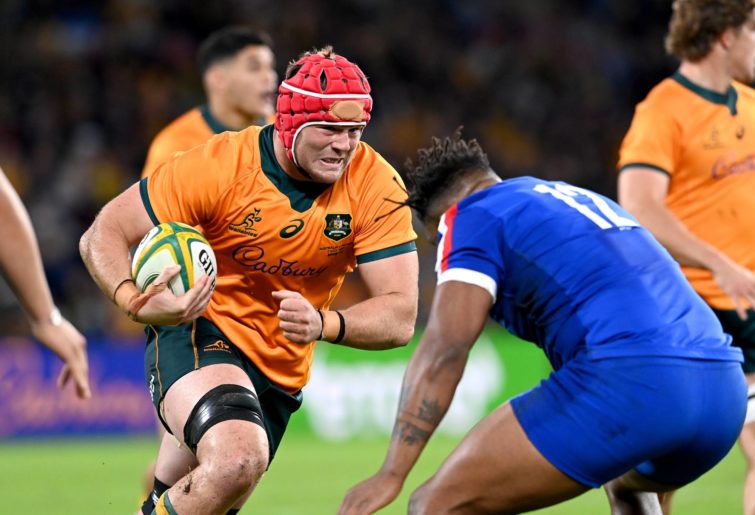This series against England marks a turning point in Deve Rennie’s tenure as Wallabies coach.
In international rugby you typically get four years to prove your worth as a coach. That’s one World Cup cycle to build a team capable of winning.
Yes, the Wallabies were in a bit of a state at the end of Michael Cheika’s time and granted, the first year was highly disrupted.
But the expectation remains that Rennie rebuilds, creates depth and brings a World Cup hopeful team to France in September next year.
The first Test of 2022 is where the proverbial rubber meets the road.
Ideally throughout 2020 and 2021, Rennie will have tested out his depth and game plan and now in 2022 he has landed on a squad the he believes can execute a strategy capable of bringing the William Webb Ellis trophy home.
Of course, there will be tinkering and there will be injuries. But with only 17 Tests between now and France, this period is about refining combinations and game plans, not soul searching.
So what is this Test series going to teach us about the Wallabies and their hopes in France next October?

(Photo by Ian Hitchcock/Getty Images)
The overseas players
The most obvious question revolves around which players Rennie is going to bring back.
As the rules currently stand, three players not contracted with Rugby Australia can be brought into the squad. For this series it is Quade Cooper, Marika Koroibete and Samu Kerevi.
Kerevi and Cooper both have deals expected to expire in May or June 2023, so theoretically could sign with an Australian Super Rugby team for 2024 and no longer be considered overseas players.
It is much more likely for Kerevi than Cooper. Koroibete, on the other hand, is contracted for another two seasons in Japan.
It is an interesting trio of players to bring back and it gives us some insight into how Rennie sees his team shaping up at the World Cup.
Kerevi and Koroibete are two of the Wallabies’ truly world-class players and would probably be included in any Test side.
Quade Cooper had a redemption story as he lead the Wallabies through an impressive Rugby Championship campaign.
But is this the wisest way to spend our three overseas selections?
With only three international slots available, you want to use them where you are going to get the most bang for your buck. Is ten, 12 and 14 the area of greatest need for the Wallabies?
The general consensus seems to be that the Wallabies’ second-row depth is the most important area of need. And while Koroibete is truly world-class, including the likes of Rory Arnold or Will Skelton and replacing Koroibete in the starting team with a Jordan Petaia is arguably more of a net positive.
Similarly, with the emergence of Tane Edmed this season, the continued development of Noah Lolesio, and the steady presence of James O’Connor, it could be argued that the Wallabies may not need Quade Cooper.

(Photo by Dan Mullan/Getty Images)
Rennie has pointed out that he initially intended on including Izack Rodda in the squad but injury ruled him out and presumably he had already arranged for the three backs to return, making it too difficult to now go and get any of Rory Arnold, Will Skelton or Adam Coleman.
So this decision shows us that Kerevi, Koroibete and Cooper are central to how Rennie wants to play and that he expects to be able to cover lock with talent at home, or perhaps one or two of Kerevi or Cooper will have returned to Australia, opening up another slot.
Starting with Kerevi, there is no doubt he has to be in the squad any time he is available. While you might not think that inside centre is a critical position, it is with the way Kerevi plays it.
The Wallabies are an entirely different team with him on the field. His ball-carrying ability is probably the best in the world.
And it is not just his raw power, he has outstanding feet. His ability to get over the gain line every time he carries on first phase puts enormous pressure on opposition defences and creates the bulk of the Wallabies’ attacking opportunities.
Rennie’s game plan will be entirely built around this man’s go-forward and so it should be, because it cannot be stopped.
Cooper’s inclusion is a decent indication that Rennie sees him as the primary playmaker for the next two years. He had his best success with Cooper at ten and truthfully, Lolesio and Edmed are not ready for Test rugby.
Koroibete is one of the world’s best wingers but is it wise using such a valuable resource on this position?

(Photo by Graham Denholm/Getty Images)
Honestly, it was quite surprising to see three backs called into the squad and no second rower.
If Kerevi and Cooper both stay overseas next season, it will be very interesting to see if Rennie can justify using his last overseas slot on a winger, no matter how good.
The lineout
Speaking of overseas players, second row is most clearly the area of need for the Wallabies. The squad for this series includes five locks, three of which are uncapped, and one of whom is more of a back-five utility player (Jed Holloway).
The biggest frustration in this area is that there is no shortage of excellent Australian locks, they all just play overseas.
The most obvious choices are Rory Arnold and Will Skelton who are in France, and Adam Coleman and even Rob Simmons, who both play for London Irish.
We can expect Matt Philip to start alongside Darcy Swain. It is probably not the series to be experimenting with Nick Frost. The older but uncapped Cadeyrn Neville could be called upon because of his enormous 202-centimetre, 123-kilogram frame.
Right behind lock as an area of concern is hooker. Brandon Paenga-Amosa started 13 of the Wallabies’ 14 Tests last year, but joined French side Montepellier on a two-year deal after last year’s spring tour.
Six different players wore the number 16 jersey as his back-up last year. This leaves a lot of uncertainty in a position that is vital to the functioning of both set pieces.

(Photo by Chris Hyde/Getty Images)
Dave Porecki, Folau Fainga’a and Lachlan Lonergan are this squad’s hooking corps with the uncapped Porecki being the presumptive starter as the most reliable thrower of the group.
How the lineout functions in this series will go a long way in shaping how Rennie proceeds towards the World Cup.
England make for an intimidating lineout and it is not impossible that English dominance here completely unravels the Wallabies.
If the Wallabies are entirely uncompetitive at lineout time, it might force Rennie’s hand when it comes to overseas selections.
The scrum
Beyond hooker, the Wallabies’ scrum looks like it is ready to rock and roll. No one is going to mistake it for the world’s best but we could see Wallabies dominance in this series.
Taniela Tupou is coming off a fitness set back and is questionable for the first Test. Ideally you have to think Rennie wants him to start as there is no player like him, but he has been so good as a finisher recently for the Wallabies, maybe that is where he is best suited.
Angus Bell is progressing really nicely too and if he can continue this trajectory, he could play a big role for the Wallabies at the next World Cup.
Prop seems to be an area where Rennie can rest easy, now it is just about facilitating the development of Bell and Tupou.

(Photo by Kenta Harada/Getty Images)
They would probably be the preferred starting duo if they can get to their potential, getting reps and building chemistry, and hopefully we do not see too much decline in the older statesmen of James Slipper and Scott Sio.
The back row
This is another area where Rennie will fancy his charges to get a job done. This is actually a fascinating test for the Wallabies’ back row.
At this point in time, the debate about the best back row in world rugby is probably between England and South Africa.
It is fair to assume Michael Hooper and Rob Valetini are rusted onto the team sheet, but Rennie still needs to figure out who fills the third spot and what the configuration is.
Harry Wilson is the bright hope of the future at number eight. But Wilson has barely featured for the Wallabies since last year’s France series and was left at home during last year’s spring tour for development purposes.
He has had a strong year for the Reds so it will be interesting to see if Rennie gives him the number eight spot this series.
If he gets the nod, it is a strong indication he sees his potential as a ball carrier being invaluable to the Wallabies at the World Cup.
The other option is Rob Leota, who started all four of the Wallabies’ spring tour Tests. Leota offers a nice complement to Valetini and Hooper as a big-bodied workhorse.
He is sure to be there at the World Cup. If Leota starts all three Tests, it is hard to see how Wilson will unseat him without an injury.

(Photo by Bradley Kanaris/Getty Images)
Centre
Centre is far from a position of concern for the Wallabies. Rennie is blessed with exceptional depth.
Kerevi will be starting at 12. But who starts at 13? Len Ikitau is the only true outside centre in the squad and should be the starter given his form for club and country recently and has plenty of experience playing along side Kerevi.
So are Hunter Paisami and Izaia Perese simply depth pieces or impact players? Does Jordan Petaia get consideration at 13?
The back three
Speaking of Jordan Petaia, Rennie has some decisions to make around the make-up of the back three.
Koroibete will start on one wing but with Tom Banks leaving for Japan next year, who is going to take over that position?
It seems very unlikely Tom Banks would be in the mix to return. He is 11 Tests short, which he certainly could reach this year, but if Rennie favours other options he may not be eligible.
Even if he is eligible, would he be a priority to bring back?
Petaia is almost certainly not ready to play 15 at Test level, but he is almost certainly the option with the highest potential.
Is Rennie brave enough to give him the experience and hope that over the next 15 Tests, he can stay healthy and develop into a Test-class fullback?
Bear in mind he will have another full Super Rugby season to learn the position.
Andrew Kellaway could be an option at fullback but that feels like a band-aid solution rather than a long-term option.
And he has been so good on the wing. If Rennie sticks with Banks, it might be because he sees an option outside the squad as the man for the job at the 2023 World Cup.



































































































